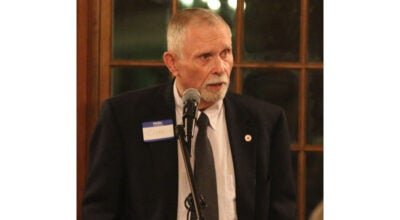Vaughan, not forgotten
Published 10:03 am Saturday, August 22, 2009
COURTLAND—When renovation of the Rebecca Vaughan House at Heritage Village/Southampton Agriculture and Forestry Museum is completed, it will be furnished in part by furniture used no doubt on occasion by Rebecca Vaughan herself.
More than a dozen pieces, including an American Empire sofa, circa 1815, an Empire mantle clock made by Seth Thomas, circa 1785, and a fall-front desk, dated about 1810, all of which came from the Vaughan family, were among the items recently donated to the historical society by the great-grandson of Mary Louisa Vaughan.
Also included were a pair of brass candlesticks, an American Empire mahogany mirror, a child’s Victorian chair, three books, dated 1787, 1826 and 1831 and a Sheraton drop-leaf table.
It is known that the sofa came from Walnut Hill Plantation, the home of Mary Louisa Vaughan, while other pieces belonged to various other members of the family.
Mary Louisa was Rebecca’s niece and was visiting her aunt when Nat Turner and his insurgents invaded Rebecca Vaughan’s home in August 1831. Only 8 at the time, Mary Louisa survived by hiding in a small trunk.
Dr. William Dunstan III, the great-grandson to whom the furniture had been handed down, said he could think of no better place for it to finally rest than at the home of his great-aunt.
Dunstan, author of four books, former editor of Virginia Cavalcade Magazine and professor of history, who grew up in Elizabeth City,
N.C., now lives in Chapel Hill, and teaches in the history department of North Carolina State University.
He said he knew very little about his family in Southampton County until about 10 years ago.
“I decided to find out what I could about Walnut Hill, the Rebecca Vaughan House and the people who lived there,” he said.
Dunstan got in touch with Kitty Futrell of Courtland, second vice president of the society and co-author of a series of tapes on the insurrection, who made arrangements for him to see both the houses.
“I was in awe at the Rebecca Vaughan house,” he said. “You could just feel that something terrible had taken place there.
Since the plantations seem to be adjoined, Dunstan said he also had a feeling that the families in the area were close and as he looked around, he could just imagine a horse and buggy transporting the relatives from one home to the other.
Dunstan kept in touch with Futrell. He learned that the historical society had acquired the Rebecca Vaughan House and planned to restore it. They were and still are in the process of applying for grants to help with the funding.
About this time, he decided to donate the furniture he had inherited to the society.
It was delivered to Courtland last week.
Futrell said the society is delighted with the gift and will store it until the house is finished.
Work has already started on the roof, she added.





